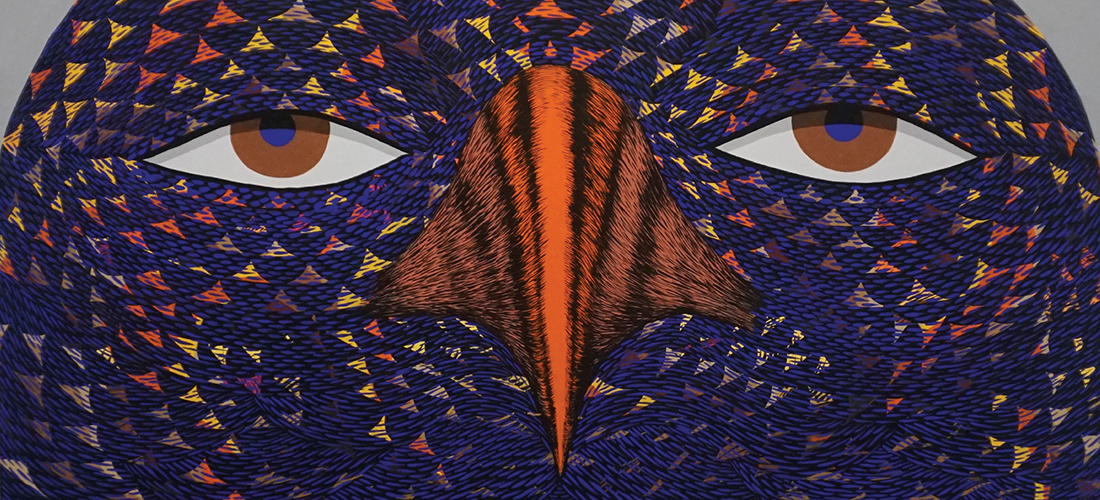
The art of David Ellis
By Jim Moriarty
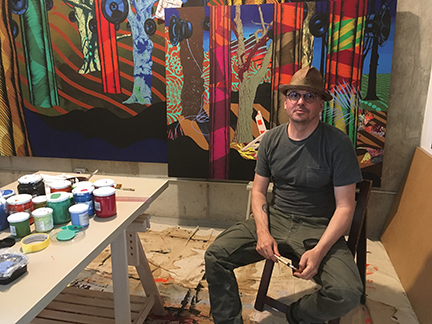
The painted barns of Cameron are mostly overgrown, tumbled-down boxes — tar paper and old boards defying gravity by the grace of a rusty nail. In some cases, it seems as though all that’s holding them up is the paint. Well, the paint and the idea that made them something more than old barns outside a tiny town that grew up over a century ago at the end of an ancient railroad. Twenty years have passed since David Ellis gathered up a bunch of his friends, artists from New York to Tokyo, to come to his hometown to do what they do, make art. Described in those days as a “street artist,” Ellis brought Brooklyn and the Bronx to the barns Earl and Juanita Harbour offered up as canvases.
“There were two massive trips with like 30 people each time, and then there were several trips when it would be me and a couple of people,” says Ellis of the group that became known as the Barnstormers. He’s sitting at the kitchen counter in his small Brooklyn apartment, having a toasted bagel for breakfast. Fresh paintings lean against the wall behind him. His architect wife, Kouki Mojadidi, tends to the plants on the porch. He’s working on his next one-man show, still two years over the horizon.
When Ellis talks, he looks off to the side, not because the answer’s out there, but because that’s where he sees all the questions. He’s interested in the questions.
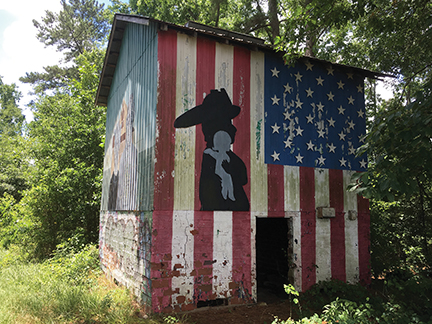
“A lot of those barns we kind of patched up a bit. The roofs were blowing off. There were vines covering them. Oftentimes, there’s a sweet spot. The vines start to overtake something. It fades, it peels. It’s like the patina of time itself. It may be faster on the exterior of a weathered barn, but the fact of the matter is all of this fades — every bit of it — even in the most climate-controlled space. The elements will take it all at some point. Might be a thousand years, might be a 100 years.”
Significant as it was in the moment, what Ellis left behind in Cameron turns out to be far less than what he took with him. “When I do return to Cameron, when I did paint those barns, there’s a cadence and a spirit in the people from Cameron that’s a big part of me,” says Ellis. “It’s who I am. It folds into everything I do and everywhere I go. Cameron people are special people. Real soulful people.”
Ellis and his younger brother, John, are the sons of a Presbyterian minister, Stewart, and his wife, Grace. Stewart nurtured the flock in a small town church. Grace nurtured the art. David has had solo exhibitions in places as far-flung as Texas, California, New York, New Zealand, Ohio, Japan. Two of his pieces have been on display in New York’s Museum of Modern Art. The main gallery representing him is Joshua Liner Gallery in New York, but his work can be found in London, Paris and L.A., too.
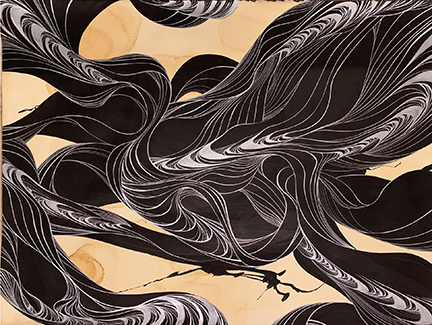
John is a musician who also lives in New York. His main instrument is the tenor saxophone, and he has appeared with Ellis Marsalis, Charlie Hunter, Dr. Lonnie Smith, Kendrick Scott Oracle, Helen Sung and Lionel Loueke, among others. With all due respect to N.C. 24/27, there are apparently two roads leading out of Cameron: professional wrestling (Shannon Moore, the Prince of Punk; Trevor Lee, the 2017 Impact X Division Champion; and the Hardy Boyz, Matt and Jeff); and art.
In Cameron, a boy’s rite of passage included time in the tobacco fields. “I must have been like 12, 13, 14 — that age,” says David Ellis. “Two or three summers. It was tough but you really appreciated getting to the end of the row. I think the reward was a Pepsi and a little pack of Nabs. You’re just so drained and you’re covered in the resin that sort of seeps out of the little hairs on the leaves. It really cuts through your skin. You take Dramamine and that kind of helps with the sickness you get. I got so sick my last summer, I couldn’t do it anymore. But I love that smell. When it’s curing in the barns, when it turns that golden brown and they truck it through town, that smell that permeates the air is just one of my favorite smells in the world.”
Ellis incorporated more than the barns into his art. He took the tobacco with him, too, using it to prepare the paper he drew and painted on. “I brought back like a whole burlap sheet of tobacco from Cameron on one of those barn trips. I used that for years to stain the paper,” he says. “I’d lay a whole floor of paper out with as many sheets as I could fit in the footprint of the studio. I’d brush and pour the stain on and let it evaporate overnight, really soak in. These amazing pools and forms would show up the next day. They’re not so much backgrounds as they are foundations. I like having something to react to, to riff against. It activates different memories. Just the smell I remember growing up — that time period, 13, 14, when you really start to find the impulses you chase your whole life.”
When Ellis couldn’t stomach priming tobacco anymore, he turned to Earl Harbour’s car wash, where the hiss of soapy water and the flapping of soft brushes danced to hip hop tunes. He’d stay up late with the volume turned down to listen to DJ Gilbert Baez on D103 FM out of Fort Bragg. The whole notion of percussion, beat, rhythm, seeped into his work as deeply as a day in the fields. He talks about his love of music in a statement on his website, davidellisstudio.
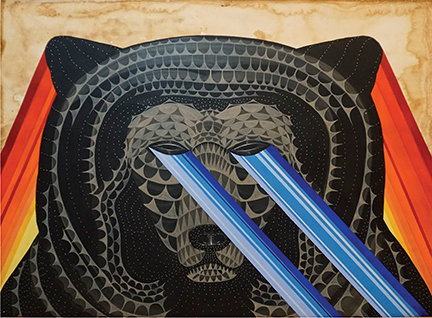
“The first nine months of your development you were listening to one of the best bass drums in the world until yours kicked in with it and you heard the best polyrhythms ever . . . I think everybody’s got a lot of music in ’em. I think that’s why you find marching bands and percussion in every form in every corner of the planet.”
That music, those rhythms, melded with one of his earliest childhood memories to form another of Ellis’ expressions, his kinetic sculptures. “Maybe I was 3,” he says, just months before his family moved to Cameron. “I remember seeing this piano play by itself.” The player piano was at an uncle’s house in Raleigh, the home of another jazz enthusiast. “It really went back to trying to figure out how these things work. I went online and I found all these discussion boards for people who restore these things. I made all the machines and bellows and stuff from scratch.”
The sculptures are collections of everyday objects, paint cans, empty bottles, stuff. View them here. Using a scroll, almost identical to the one in a player piano, he pulls tones and rhythms from the sculpture. “A painting, essentially, is a drum. It’s a membrane stretched over a frame. We think of them for the visual resonance but when you’re preparing a panel you often tap it. The under layers of rabbit skin glue dries, it tightens up the pores of the canvas, and you get a drum sound. And I wanted to go more in the sonic direction.” Examples like The Message, True Value and Trash Talk — some done in collaboration with Roberto Lange — can be viewed on his website.
Not long after abandoning the car wash, at 16 Ellis was off to the North Carolina School of the Arts. “It was clear to me and to everyone around me at a very young age that I was totally absorbed in making things. I didn’t have a lot of patience for a lot of things, but making things, painting things, drawing things, sculpting things — I’d just spend days on them,” Ellis says.
“I think you would call him a prodigy,” John Ellis says of his older brother. “He might resist that characterization, but it’s certainly what it seems like to me.” John, in fact, followed David to the School of the Arts, where both brothers blossomed.
“In terms of formal education I’d say maybe that school added the most fuel to what I was already working with,” says David. “The dean of the art school was Clyde Fowler. He was the drawing teacher, but the drawing class was way more than just drawing. He was showing us film and painting techniques. He just blew everybody’s mind. If you wanted to have your mind blown, it was blown. He passed away not to long ago. He helped a lot of people with their dreams.”
With their boys at the School of Arts, the parents moved to Winston-Salem. Stewart, now retired, aligned with Trinity Presbyterian Church there, and Grace wrote poetry (Sam Ragan published some of her work in The Pilot in their Moore County days) and plays, something she’d begun doing in Cameron when she penned Through the Depot Door to celebrate Cameron’s centennial. She’s been a member of Greensboro’s Playwright’s Forum for more than 20 years and has started a group called the Triad Playwright’s Theater, which recently performed one of her works, Rhonda’s Rites of Passage. David Ellis finished his formal education in New York at the School of Visual Arts and then The Cooper Union.
Though the Barnstormers took on something of a life of their own, there aren’t any card-carrying members. It was never meant to be a “thing,” a traveling carnival of artists. There have been projects since Cameron, but they’ve been few. In 2004 a group of them came together to do a project for the Southeast Center for Contemporary Art in Winston-Salem.
“We took one of the Harbours barns apart piece by piece, put it on a flatbed, drove it to Winston, rebuilt it in the museum and we shot time lapse (video) of it coming down and coming back up,” says Ellis. “Over the course of two months we’d fly artists down from New York, Tokyo, some other places, to paint the barn. That was filmed. Then the next person would come in and paint over that thing. That was filmed. Then we took the barn apart and put it back up in Cameron and covered it with tar paper.”
There was one other Barnstormer family reunion, at the Joshua Linear Gallery — a Barnstormers version of The Band’s The Last Waltz. “It was never really meant to be all that formal,” says Ellis of the group. If an invitation for another collaborative project was to come down the road, Ellis isn’t even sure he’d want to call it Barnstormers “out of respect for what we’ve all done together.”
The kind of time-lapse painting he brought to Winston-Salem is another of his core expressions, what he calls his motion paintings. They can be viewed here. “It was a way for me to look back and be like, ‘Oh, man, I wish I’d stopped there,’ or ‘It’s interesting I changed that.’ And then it became this fluid, creation, destruction, creation, destruction sort of moment. It wasn’t, for me, about a start-to-finish thing. It was about this thing is constantly changing. I still return to that. I think it taps into the improvisational kind of music side of the brain. I go back to that Tibetan idea that no condition is permanent. Like the mandalas that are painted with sand, then the wind blows them away and you make it again.”
Walter Robinson, an editor of Artnet Magazine, wrote, “Whatever Ellis makes in one moment is erased in the next. What was just done is gone before you can even see what it is. The stop-action is mesmerizing and magical but at the same time it’s no mystery, anyone can see how it’s done, just pictures, pictures, pictures, painted one after the other step by step. But it adds up to a perfect art film . . . .” It was one of his motion paintings, this time of a moving van in Osaka, Japan, that found its way to MOMA. Some of his motion paintings, sometimes solo, sometimes in collaboration, can be viewed on his website, as well.
When the Barnstormers were in Cameron doing what they do best, Cameron did what it does best — it threw a pig pickin’. “You get one artist making something, there’s a lot of energy generated,” says Ellis. “You get like 20, 30 artists all working in a compressed amount of time with a community where it’s a little bit out of the ordinary for that to happen, the energy that was generated between the artists and the people of Cameron, that was amazing. The feedback we had, the sitting down and having a pig pickin’ covered in paint. . . it was electric.”
It was the sweet spot. PS
Jim Moriarty is senior editor of PineStraw and can be reached at jjmpinestraw@gmail.com.





